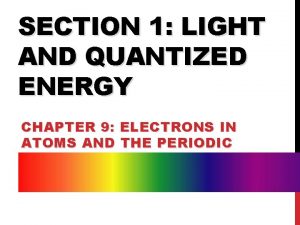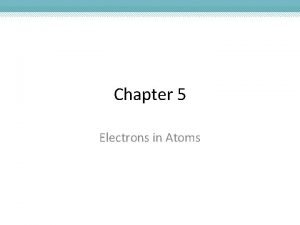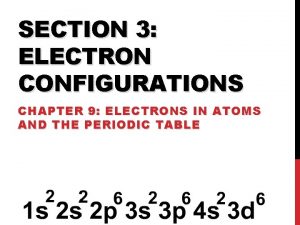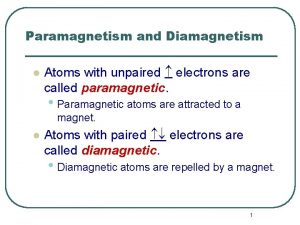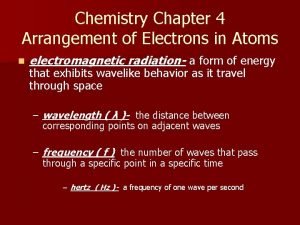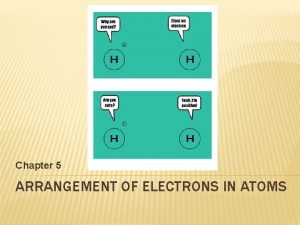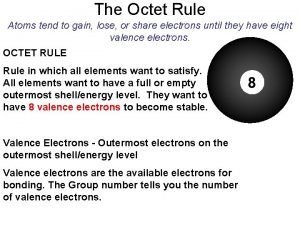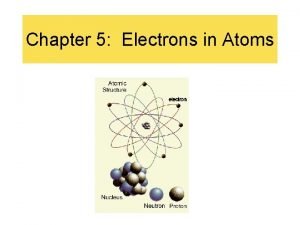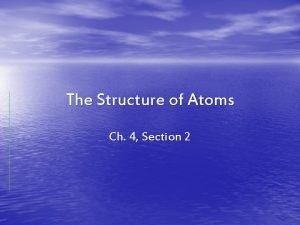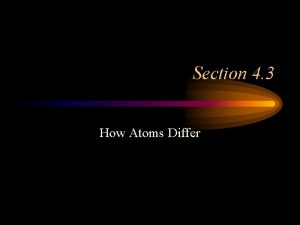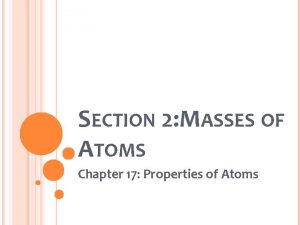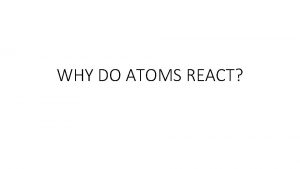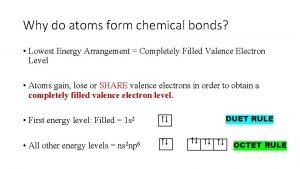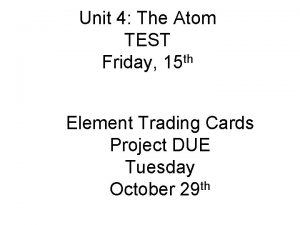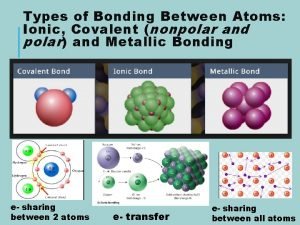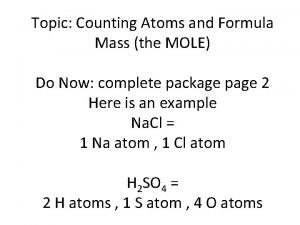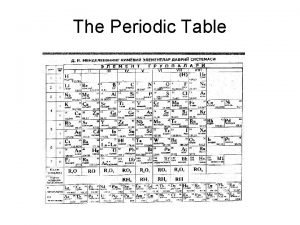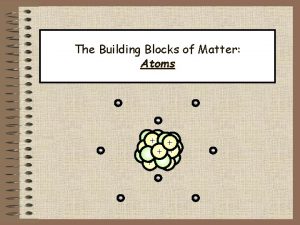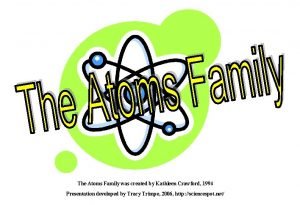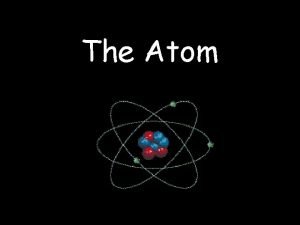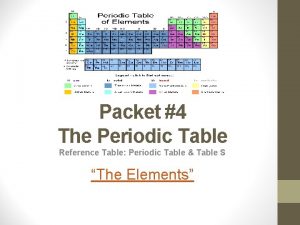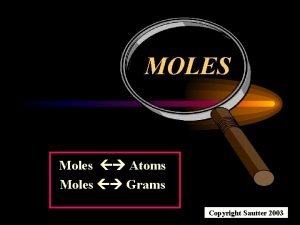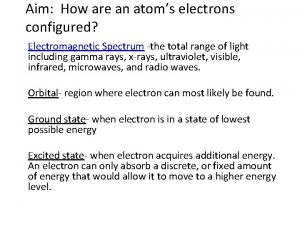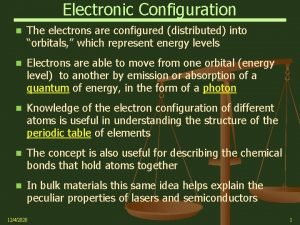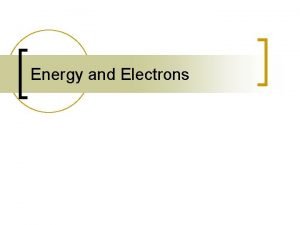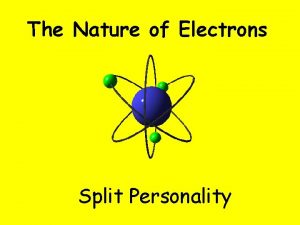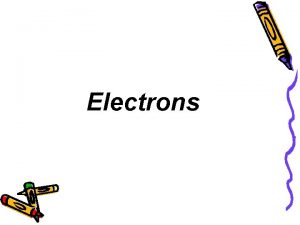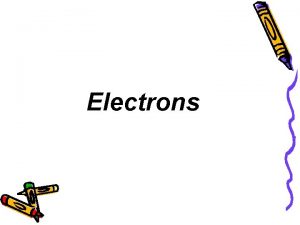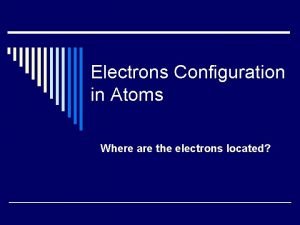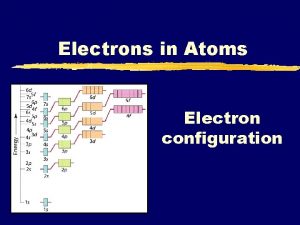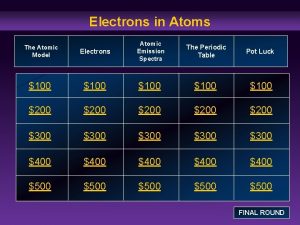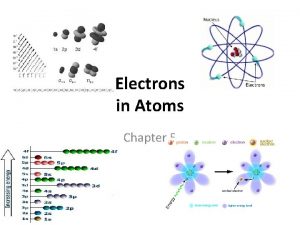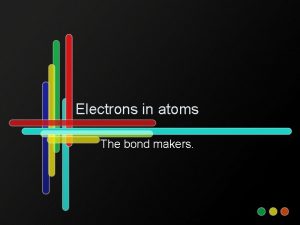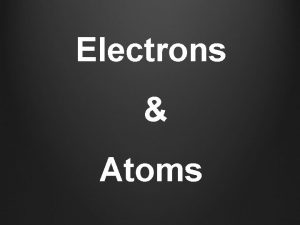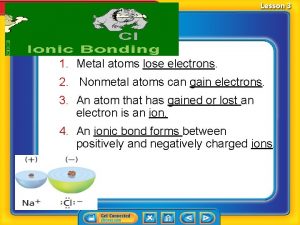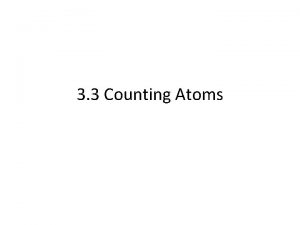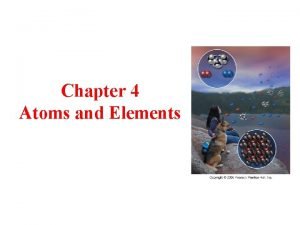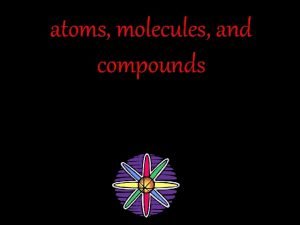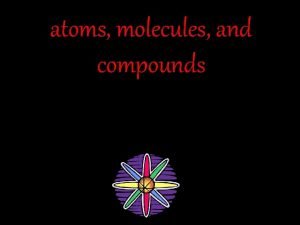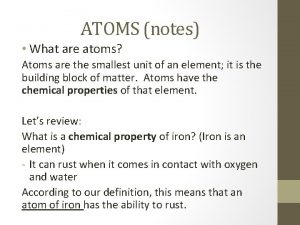How are an atoms electrons configured Section 3














































- Slides: 46

How are an atom’s electrons configured? Section 3. 3 1

Electrons n Most important part of an atom to chemists. n Light emission n Electromagnetic spectrum 2

Electromagnetic Spectrum 3

Light is an Electromagnetic Wave n Prism n Waves can be described using speed, wavelength, and frequency. 4

Light Travel n Light travels at a constant speed. n The speed of light equals 8 2. 998 x 10 m/s n 500 seconds to travel 150 million km from sun to Earth 5

Wavelength n Wavelength – distance between 2 consecutive peaks or troughs of a wave (measured in meters) n Range from 10 -13 for gamma rays to over 105 for radio waves 6

Frequency n Frequency – the number of waves that pass thru a stationary point in one second n One wave per second is a hertz, Hz, (the unit for frequency) n Ranges from less than 1000 Hz to more than 1022 Hz 7

Light Waves n High frequency/ low wavelength n Low frequency/ high wavelength 8

Relationship Frequency x wavelength ______ Speed of light 9

Calculations n The wavelength of red light is 7. 6 x 10 -7 m, calculate the frequency. n F = speed = 2. 998 x 108 m/s wavelength 7. 6 x 10 -7 m 10

Calculations n Frequency = 3. 9 x 1014/s 14 = 3. 9 x 10 Hz 11

Line Emission Spectra n Purple hydrogen gas n Splits and sent to prism n Line-emission spectra n Lines of colored light produced when the light from excited atoms of an element is passed thru a prism 12

Excited electrons emit light n Bohr theory – an electron can exist in different energy states n Electrons can move to different energy levels. n Gain energy n Lose energy 13

States n Ground state – lowest possible energy state an e- can be in n Excited state – e- can move here when it gains energy 14

Excited State n Unstable State n Higher energy than ground state n Electrons can “fall” from excited state to ground state and give off energy in the form of light 15

Excited State n When the electron gives off energy, it is associated with a frequency that reflects the energy released. n We see a color which produces the line emission spectra. 16

Energy of an electron n Energy of an electron = -2. 179 x 10 -18 J n 2 n n is any positive whole number 17

Quantum Number n If n has only certain values it can be, it is called a quantum number n The energy is said to be quantized n The effects are only apparent at the atomic level 18

Concept Check 1. 2. 3. What is the line emission spectra? What does it mean to say that energy is quantized. Look at fig 3 -20. What wavelengths and frequencies define light in the visible spectrum? 19

Orbitals Replace Orbits n Bohr’s atomic model describes electrons in terms of E states. n Present quantum model says ehave properties of particles and waves. 20

Quantum Numbers n Each e- in an atom is assigned 3 quantum numbers: n, l, m n Q #’s are like seats at a concert – section, row, and seat number 21

Orbitals n e- are located in orbitals n Orbitals are regions in space that you are likely to find an en They are like e- clouds n Only certain combinations are acceptable. 22

Rules for Assigning Quantum #’s n Principal quantum number – n n n has to be a whole number and typically is not higher than 7 n The larger n is, the further from the nucleus the e- is and the higher the energy is 23

Rules for Quantum Numbers n The l quantum number can be a whole number between 0 and n-1 n If n = 3, l can be 0, 1, or 2 24

l Quantum Number n When l = 0, it is called the s orbital. l = 1, is the p orbital, l =2 is the d orbital, and l=3 is f orbital n If n = 3 and l = 1, it is the 3 p orbital. n 3 p electron 25

m Quantum Number n Can be a whole number n Depends on l quantum number n If l = 1, m can be -1, 0, or 1 n There can be 3 different p orbitals 26

l and m quantum numbers n They indicate shapes and orientations of the orbitals. n Quantum theory tells us the exact energy, but not the exact location of the e-. It only tells the probability of the location of the e 27

Orbitals 28

Quantum Numbers Quantum # Meaning n Main E Only up to 7 Level Angular Up to n-1 Momentum l=0=s l=1=p l=2=d l=3=f Magnetic s=1 p=3 Quantum # d=5 f=7 Spin +1/2 or -1/2 l m Limits of Number 29

Pauli Exclusion Principle n No more than two e- can occupy a single orbital at a time n e- spin in opposite directions n Spin quantum number, m n m can be +½ or -½ 30

Electron Configuration n. A description of the electron orbitals in an atom n Aufbau principle – electrons in an atom will occupy the lowest energy orbitals available. 31

Electron Configurations n Remember, the smaller the principal quantum number, the lower the energy, and the smaller the l quantum number, the lower the energy 32

Electron Configurations n The order in which energy levels fill is … 1 s<2 s<2 p<3 s<3 p 33

Electron Configurations n After this, the energy levels are less straightforward n The E levels of the 3 d orbitals are slightly higher than those of the 4 s orbitals. 1 s<2 s<2 p<3 s<3 p<4 s≈3 d 34

Electron Configurations n The next irregularity is 5 s and 4 d are close in energy 1 s<2 s<2 p<3 s<3 p<4 s≈3 d<4 p<5 s≈4 d n Still more irregularities exist with higher energy orbitals. 35

Electron Configurations n Tells us how the 16 e- of S are configured n The electron configuration for S is n S=1 s 22 p 63 s 23 p 4 n Each s orbital has 2 e-, each p orbital can have 6 e- (2 per orbital) 36

Electron Configurations n To save space, some configurations are written like n S = [Ne]3 s 23 p 4 n This means take neon’s configuration and add 3 s 23 p 4 to the end of it. 37

Electron Configurations n There are still some irregularities with higher energy orbitals. n Chromium is an example of this n Cr = [Ar] 3 d 54 s 1 n There is one unfilled d orbital and a filled s orbital 38

Electron Configurations n There are e- configs listed in the p. t. in the back of your book. n These are the ground state configs of the isolated atoms in the gas phase. n Under other conditions, the configs could be different 39

Rules for Writing e- Configs 1. Determine the # of e- the atom has (atomic #) Fluorine as an example has 9 electrons 40

Rules for Writing e- Configs Fill orbitals in order of increasing energy S orbital – 2 e. P orbitals – 6 e. D orbitals – 10 e. F orbitals – 14 e 2. 41

Rules for Writing e- Configs 42

Rules for Writing e- Configs n 3. The configuration for F is 1 s 22 p 5 Make sure the total number of e- in the config match the atomic number 43

Orbital Diagrams boxes to show e- location n Boron = 1 s 22 p 1 n The orbital diagram looks like… 1 s { 2 s n Use 2 p 44

Orbital Diagrams n Hund’s Rule says the maximum stability for e- is when you have the maximum number of unpaired electrons when they have the same quantum number. 45

Orbital Diagrams n What is the Carbon orbital diagram. n The config is 1 s 22 p 2 46
 Mikael ferm
Mikael ferm Electrons in atoms section 1 light and quantized energy
Electrons in atoms section 1 light and quantized energy Electrons in atoms section 1 light and quantized energy
Electrons in atoms section 1 light and quantized energy Electrons in atoms section 2 quantum theory and the atom
Electrons in atoms section 2 quantum theory and the atom Electrons in atoms section 2 quantum theory and the atom
Electrons in atoms section 2 quantum theory and the atom Electrons configurations
Electrons configurations Periodic table regents
Periodic table regents Atoms with 4 valence electrons
Atoms with 4 valence electrons Diamagnetic elements
Diamagnetic elements Periodic table protons neutrons electrons
Periodic table protons neutrons electrons Chapter 4 arrangement of electrons in atoms
Chapter 4 arrangement of electrons in atoms Stable electron configurations are likely to contain
Stable electron configurations are likely to contain Chapter 5 arrangement of electrons
Chapter 5 arrangement of electrons Aluminum chloride charge
Aluminum chloride charge How do chemists model the valence electrons of metal atoms?
How do chemists model the valence electrons of metal atoms? Ionic and metallic bonding chapter 7 practice problems
Ionic and metallic bonding chapter 7 practice problems 5 electrons in atoms
5 electrons in atoms Chapter 4 section 2 the structure of atoms
Chapter 4 section 2 the structure of atoms Section 1 atoms elements and compounds
Section 1 atoms elements and compounds Chapter 6 section 1 atoms elements and compounds answer key
Chapter 6 section 1 atoms elements and compounds answer key Section 3 how atoms differ
Section 3 how atoms differ Chapter 6 section 1 atoms elements and compounds
Chapter 6 section 1 atoms elements and compounds Section 2 masses of atoms
Section 2 masses of atoms Revolve section view
Revolve section view What is a revolved section view
What is a revolved section view Full section
Full section Work and energy section 2 describing energy
Work and energy section 2 describing energy Concept mapping chapter 10 meiosis 1 and meiosis 2
Concept mapping chapter 10 meiosis 1 and meiosis 2 Why do atoms react?
Why do atoms react? Why do atoms form chemical bonds?
Why do atoms form chemical bonds? What is the relationship between atoms and elements
What is the relationship between atoms and elements What are atoms?
What are atoms? Kesler science biotic and abiotic factors answer key
Kesler science biotic and abiotic factors answer key The atoms family atomic math challenge answer key
The atoms family atomic math challenge answer key Ionic metallic and covalent bonds
Ionic metallic and covalent bonds How to count atoms in a formula
How to count atoms in a formula How to arrange elements in increasing atomic size
How to arrange elements in increasing atomic size Atoms as the smallest building block of matter
Atoms as the smallest building block of matter Atoms family song
Atoms family song Whats inside an atom
Whats inside an atom Periodic reference table
Periodic reference table How to find moles from grams
How to find moles from grams Atomic mass unit
Atomic mass unit Metallic bonds occur between atoms of
Metallic bonds occur between atoms of Atoms escape room digital locks answers
Atoms escape room digital locks answers Mri hydrogen atoms
Mri hydrogen atoms Planar density examples
Planar density examples

